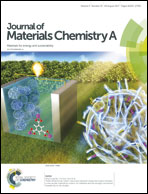Seed-assisted smart construction of high mass loading Ni–Co–Mn hydroxide nanoflakes for supercapacitor applications†
Abstract
Smartly designed nanoarchitectures with effective hybridization of transition metal oxides/hydroxides are promising to realize high performance electrodes for energy storage devices. To promote the applications of high-power supercapacitors, a seed-assisted method is firstly applied to prepare mesoporous Ni–Co–Mn hydroxide nanoflakes (NCMH) on nickel foam with practical mass loadings (higher than 5 mg cm−2). Further mechanism study reveals that the Ni(OH)2 nanorod arrays, which are firstly prepared by a hydrothermal process, serve as seeds for the successful deposition of NCMH nanoflakes. Through this convenient and cost effective method, this design results in a more orderly spatial distribution, lower intrinsic resistance and shorter electron transport pathways. The proof-of-concept application of NCMH as a binder-free supercapacitor electrode reveals an impressive specific capacity of 1043.1 μA h cm−2 at a high mass loading of 5.2 mg cm−2. The NCMH//activated carbon asymmetric device delivered a maximum energy density of 55.42 W h kg−1 at a power density of 750 W kg−1, exhibiting great potential as an energy storage device and shedding light on the structural design of nanomaterials.



 Please wait while we load your content...
Please wait while we load your content...